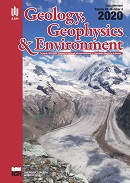The application of volume texture extraction to three-dimensional seismic data – lithofacies structures exploration within the Miocene deposits of the Carpathian Foredeep
Main Article Content
Keywords
Carpathian Foredeep, channel system, seismic attributes, Machine Learning, Grey Level Co-occurrence Matrix
Abstract
There are numerous conventional fields of natural gas in the Carpathian Foredeep, and there is also evidence to suggest that unconventional gas accumulations may occur in this region. The different seismic sig-natures of these geological forms, the small scale of amplitude variation, and the large amount of data make the process of geological interpretation extremely time-consuming. Moreover, the dispersed nature of information in a large block of seismic data increasingly requires automatic, self-learning cognitive processes. Recent developments with Machine Learning have added new capabilities to seismic interpretation, especially to multi-attribute seismic analysis. Each case requires a proper selection of attributes. In this paper, the Grey Level Co-occurrence Matrix method is presented and its two texture attributes Energy and Entropy. Haralick’s two texture parameters were applied to an advanced interpretation of the interval of Miocene deposits in order to discover the subtle geological features hidden between the seismic traces. As a result, a submarine-slope channel system was delineated leading to the discovery of unknown earlier relationships between gas boreholes and the geological environment. The Miocene deposits filling the Carpathian Foredeep, due to their lithological and facies diversity, provide excellent conditions for testing and implementing Machine Learning techniques. The presented texture attributes are the desired input components for self-learning systems for seismic facies classification.
Downloads
References
Eichkitz Ch.G., Amtmann J. & Schreilechner M.G., 2013. Calculation of grey level co-occurrence matrix-based seismic attributes in three dimensions. Computers & Geosciences, 60, 176 –183.
Gao D., 1999. 3D VCM seismic textures: A new technology to quantify seismic interpretation. [in:] 69th Annual International Meeting, SEG, Expanded Abstracts, 1037–1039.
Gao D., 2002. Seismic textures aid exploration. Offshore, 62, 9, 65.
Gao D., 2003. Volume texture extraction for 3D seismic visualisation and interpretation. Geophysics, 68, 1294–1302.
Hall-Beyer M., 2017. GLCM texture: A tutorial v. 3.0 March 2017. https://prism.ucalgary.ca [access: 1.11.2020].
Haralick R., 1979. Statistical and structural approaches to texture. Proceedings of the IEEE, 67, 786–804.
Haralick R., Shanmugan K. & Dinstei I., 1973. Textural features for image classification. IEEE Transactions on Systems, Man, and Cybernetics, 6, 610–621.
Infante-Paez L. & Marfurt K., 2019. Using Machine learning as an aid to seismic geomorphology, which attributes are the best input? Interpretation, 7, SE1–SE18.
Kupidura P., Górski K., Jeżowska W. & Jankowska A., 2015. Analysis of impact of an edge effect on efficacy of selected texture analysis methods. Teledetekcja Środowiska, 53, 15–26.
Marfurt K., 2018. Attribute Selection: Machine Learning vs. Interactive Interpretation. https://www.geoinsights.com/attribute-selection-machine-learning-vs-interactive-interpretation [access: 1.06.2020].
Marfurt K. & Chopra S., 2007. Seismic attributes for prospect identification and reservoir characterization. Geophysical Developments Series, 11, SEG Books.
Myśliwiec M., 2004. Mioceńskie skały zbiornikowe zapadliska przedkarpackiego. Przegląd Geologiczny, 52, 581–592.
Pietsch K., Porębski S. & Marzec P., 2010. Wykorzystanie sejsmostratygrafii do rozpoznania rozkładu mioceńskich facji zbiornikowych w północno-wschodniej części zapadliska przedkarpackiego. Geologia: Akademia Górniczo-Hutnicza im. Stanisława Staszica w Krakowie, 36, 173–186.
Reed T.B. & Hussong D., 1989. Digital image processing techniques for enhancement and classification of Sea-MARC II Side Scan Sonar imaginery. Journal of Geophysical Research, 94, 7469 –7490.
Roden R., Smith T. & Sacrey D., 2015. Geologic pattern recognition from seismic attributes: Principal component analysis and self-organizing maps. Interpretation, 3, SAE59–SAE83.
Vinther R., Mosegaard K., Abatzis I., Andersen C., Vejbaek O.V., If F. & Nielsen P.H., 1996. 3D seismic texture classification. [in:] European 3-D Reservoir Modelling Conference, Stavanger, Norway, April 1996, 57– 63.
Wrona T., Pan I., Gawthorpe R. & Fossen H., 2018. Seismic facies analysis using machine learning. Geophysics, 83, O83–O95.
Wysocka A., 2006. Klastyczne utwory badeńskie Roztocza – przebieg sedymentacji w północnej marginalnej strefie basenu zapadliska przedkarpackiego Przegląd Geologiczny, 54, 430–437.
Wysocka A., 2016. The Middle Miocene of the Fore-Carpathian Basin (Poland, Ukraine and Moldova). Acta Geologica Polonica, 66, 351–401.
Zhang Z. & Simaan M., 1989. Knowledge-based reasoning in SEISIS: A rules-based system for interpretation of seismic sections based on texture. [in:] Aminzadeh F. & Simaan M. (eds.), Expert Systems in Exploration, Society of Exploration Geophysicists, 141–159.


